What is the development approval or town planning permitting process?
Development approval, which is also called a permit or a planning permit, is a legally binding agreement from the right authority that says a development can happen on a certain site based on the rules of the planning scheme.
The permit process begins after the selection of a development site and before the start of the construction. You can determine the project’s viability by performing several activities such as design, cost estimates, economics, market research, etc.
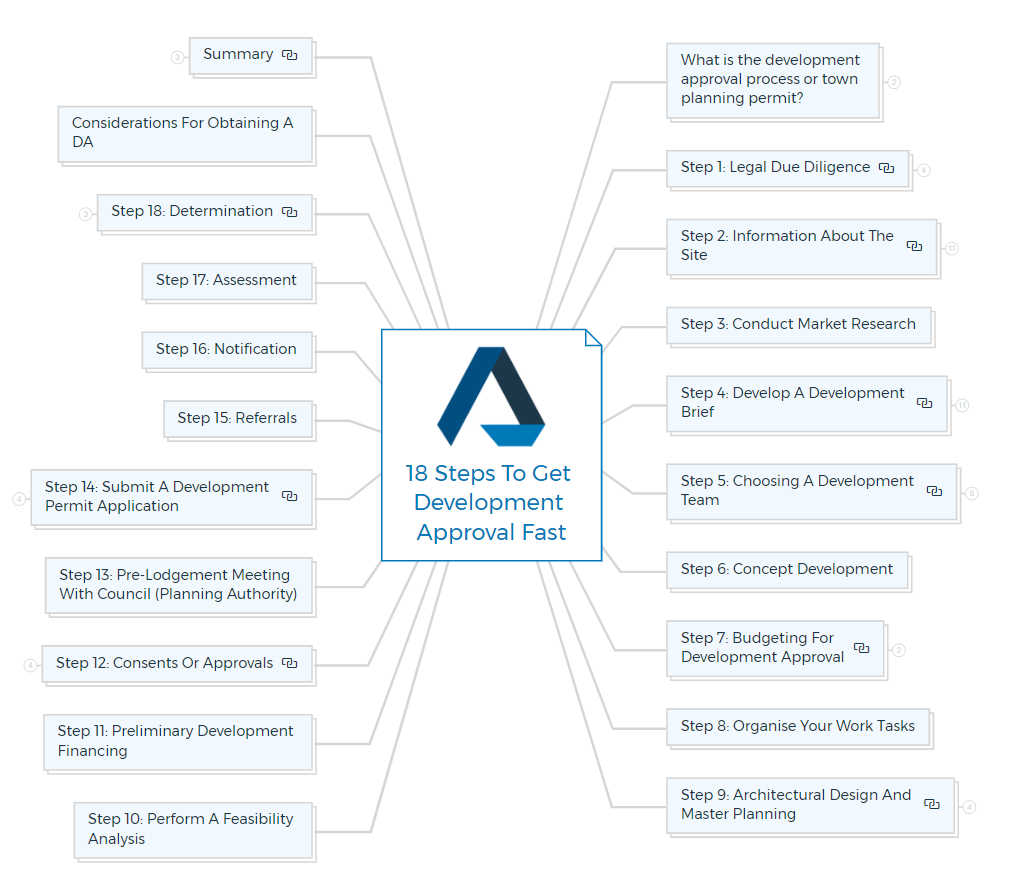
The development approval process
The table below depicts the procedure and the steps that each team member must do.
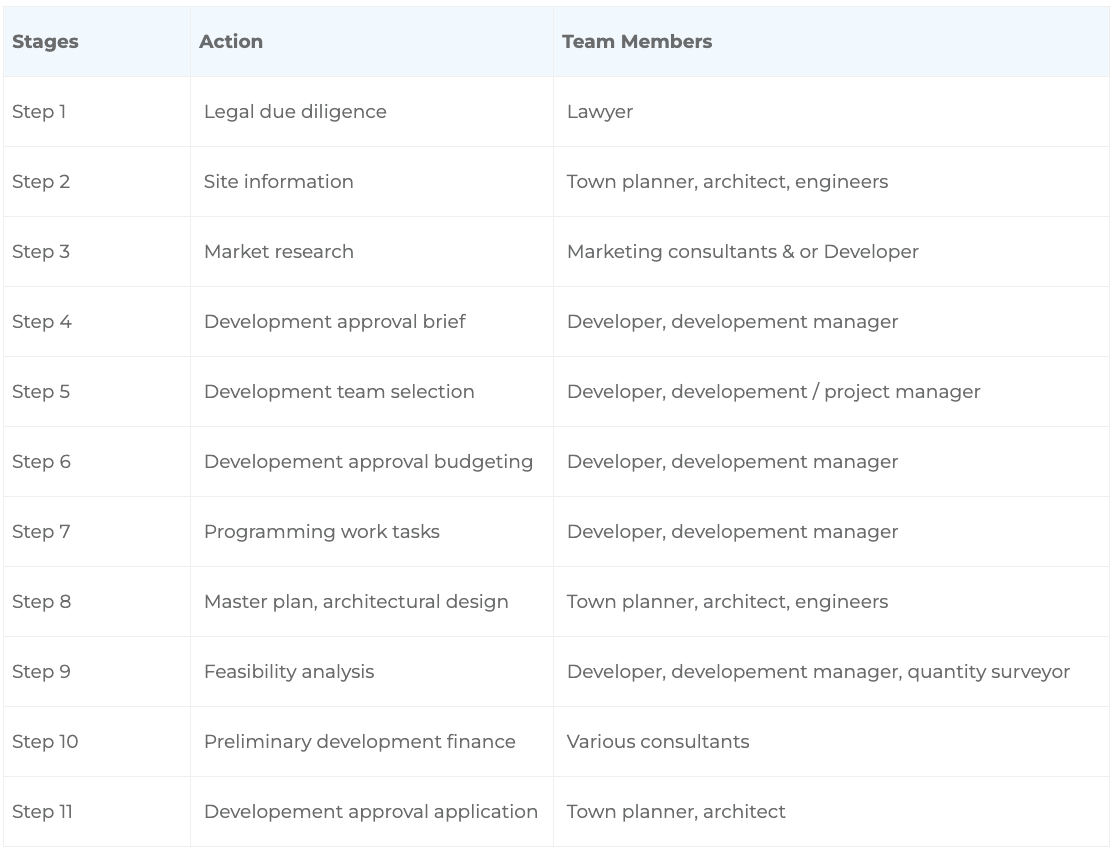
Town Planning Permit Vs Building Permit
Town planning permit (development approval) and building permit (building approval) are two separate processes that often confuse new developers.
A development approval permits you for the development or land use by ensuring that it complies with local planning schemes and other regulatory policies.
While, the building permit assures that the structure is sound and follows all construction regulatory laws and building codes & standards. It also requires that a licensed or registered builder is doing the work.
You will get a planning permit before the issuance of the building permit. Because not all construction or development activity necessitates a permit, it's good practice to double-check with the appropriate authority before filing for either.
Below are crucial 18 steps to DA approval process
Step 1: Legal due diligence
Before beginning the development approval procedure, it is critical to conduct due diligence. Typically, all legal concerns are handled by a lawyer who specialises in real estate development. The following are some of the areas that a lawyer should cover:
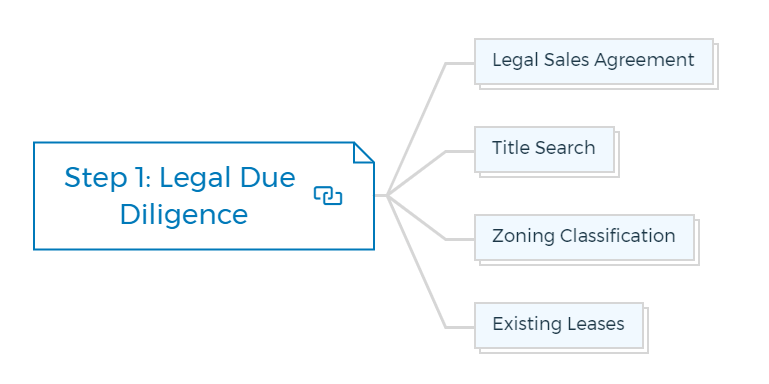
Legal sales agreement
Initially, the lawyer will develop and assist in negotiating the land acquisition agreement.
Title search
The lawyer conducts a title search to confirm the current owner and identify any restrictions on the title, such as easements. Because most developers will be unable to finance a property with title restrictions, the sooner they are aware of potential title issues, the more time they will have to address them.
Zoning classification
A lawyer confirms the property's zoning regulations with the local planning authority. The appointed architect or municipal planner can help in this. It is critical to validate and verify the zoning and relevant information in writing.
Existing leases
If the property has any existing leases, the lawyer should go over the terms and circumstances of those leases. If the developer must terminate the current leases, the lawyer can provide legal advice.
Step 2: Information about the site
Before the design team may begin working on more comprehensive schematic architectural plans, it is critical to acquire specific engineering data.
The commissioned consultants gather and analyse data before making recommendations on improving existing conditions to suit the real estate projects.
Your consultants must identify trouble areas to reduce the developer's risks. The engineering data cover the following regions.

Regulations governing planning
The architect or town planner will meet with the developer to discuss the concept at the approval stage. Next, the developer will provide the architect with essential property information, including the land's location, size (area), current zoning, a copy of the topographic survey, and the design brief.
Following the evaluation, the architect will call the local planning and building authority to confirm the current zoning and identify the required construction codes for the task.
Site survey
A land surveyor should complete an updated topographical and feature survey of the site. The surveyor will conduct on-site fieldwork and then produce a drawing that depicts the terrain and other aspects of the site and the structures of nearby neighbours.
This drawing will aid the architect in assessing the design concerning the site's attributes. You should include the following information in a standard site survey:
- Particulars of the title
- Poles for street lighting
- Location of the property
- A stormwater catchment area
- Date of the survey
- Sewage system locations
- A water supply location
- The scale of the drawing
- A gas supply location
- Easements that already exist
- A site where electricity is available
- Ways of travel
- Buildings on the same property
- Telecommunication service location
- Location of any existing structures
- Direction of views
- Existing fences' placement
- Lakes, ponds, and streams
- Trees and vegetation that already exist
- Existing pavements utility pole placements
- Locations of rock outcroppings
- Streets and parking lots that are already in place
- Predetermined contour intervals
- Locations of extant structures
In my Quick-start property development course, I will navigate you to all the inherent complexities of property development. You will be able to apply the right property development strategy with the most significant profit.
Report on geotechnical issues
Geotechnical engineers will carry out this work. Unknown soil conditions can increase the cost of a new development significantly. Rock formations, underground water, clay conditions, and toxic soil are examples of situations that could be costly to remove or treat.
If any of these problems are discovered, there should be a renegotiation in the site's pricing. The following factors are considered while determining soil conditions:
Soil samples
Samples are gathered at various subsurface depths and examined to determine the contents of the soil.
Seismic tests
If rock is discovered, seismic tests are used to determine the depth of rock formations by employing sound waves.
Compaction tests
These tests are used when dirt has been transported to a different location on the property. They determine the new soil's compact strength.
Water tests
These tests determine how much water is absorbed by the soil.
Analyze the traffic
The new development often increases the number of people and automobiles. Traffic engineers research how traffic moves in response to population expansion.
They are qualified to design roads in response to anticipated traffic challenges. Most authorities will demand a traffic effect analysis submitted with a DA or town planning application.
Services related to utilities
There are existing utility services such as water supply, sewage, and gas. In that case, the hydraulics engineer should confirm whether the new development will impact these existing utilities.
If so, at what cost to the project. The electrical engineer also evaluates electrical power and telecommunications.
Retention and disposal of stormwater
Civil engineers will collaborate with regulatory agencies in charge of wetlands and waterway maintenance. Local governments will want a strategy for releasing water from the construction site.
Environmental site assessments (ESA)
Environmental testing may be used to verify the existence of chemical contaminants in the air or soil in a built-up region where an older building is removed. A new ('greenfield') project on virgin soil necessitates resolving several environmental challenges involving both government and public agencies.
These environmental studies, which could include an examination of a development site's environmental impact or recommendations for creating an environmentally sustainable project, can be handled by an environmental consultant.
Step 3: Conduct market research
Market research is highly crucial in the success of a development project. To direct and inform the design team, the developer will need to do market research on the renters or buyers of the proposed development.
The study is based on market trends, demographics, competition, and current market conditions gathered by marketing consultants. Market research firms, real estate agents, and property valuers are all examples of marketing consultants.
All reasonable development decisions start with accurate and impartial market research. The following are some study topics to consider:
- Analyses of demographics and target markets
- Market characteristics and trends
- Market information by location
- Product and pricing recommendations are included in the project analysis.
- A study of project activity in a competitive environment
- Analysis of price and sales
- Advice on rental and investment properties, including return analysis
- Monetary indicators
- Focus groups are part of social research.
Step 4: Develop a development brief
A well-defined development brief is critical since it serves as a roadmap for success. The developer and the development manager should determine what is best for the site and target market and then write their conclusions.
These judgments, documented in a formal document, will aid team members in understanding the project's goals and providing realistic cost and programme design suggestions.
A development brief consists of several essential points that outline the project's objectives and achieve them. A well-informed team with a clear understanding of the project's goals will be better able to deliver a high-quality project on time and within budget.
A list of items to cover in brief is provided below.
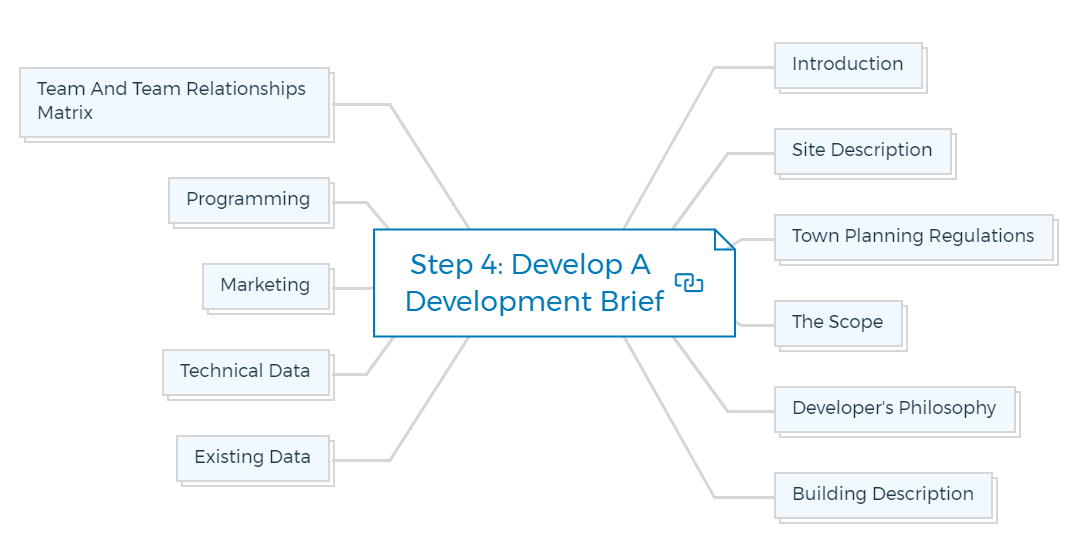
Introduction
The project's primary goals and objectives are described in the introduction. It should describe the development's vision and respond to the market.
Site description
The site plan, aerial images, location maps, existing border and topographical drawings, site analysis studies, and any other site features are included in the site description.
Town planning regulations
The appropriate town planning ordinances, zoning, revisions, restrictions, covenants, and any related drawings, should be included in this section.
The scope
It includes a detailed description and the size of the task. This covers tasks that must be completed during the pre-construction phase and have specific objectives.
Developer's philosophy
Include any unique developer requirements for the project, as well as the developer's strategy, aims, beliefs, and value system.
Building description
Experienced advisors should handle this area if the developer is a beginner. A list of data that will be required is as follows:
- Height limitation
- Creating a structure
- Ideal ceiling-to-floor heights
- Theme and aesthetics from the outside
- Intrinsic personality and design
- The total area of the building
- The field of telecommunications
- Protection from fire
- Ceiling fixtures
- Provisions for disabled people
- Mechanical equipment
- Arrangements for communication
- Energy efficiency
- The size of the tenant's space, unit size, unit mix, or room mix
- The number of apartments or rooms per floor or the size of the floor
- Parking restrictions
- Open areas
- Areas of service
- Surveillance systems
- Illumination both outside and inside
- Unique characteristics
- Systems for art, graphics, and signage
- Preferred materials and colours
- Arrangements for furniture, fixtures, and equipment
- Growth or phasing in the future
- Landscape concept to the project's overarching goal
Existing data
This part should include any existing data from the prior project site owner that will provide insight for the team, such as existing designs.
Technical data
Any geotechnical and environmental assessment studies and topographical surveys should be included if they are available. If not, these are chores that need to be completed.
Marketing
An explanation of the project's marketing strategy will give the team insight into the tactics to employ in the project's sale or lease.
The early marketing research and results and rivals' products should be included so that the team may give amenities and features that appeal to the market.
Programming
The developer must generate a preliminary programme that specifies all operations related to cash flow demands to prepare accurate proposals and timetables for the project. As the project proceeds, you need to update the software.
Team and team relationships matrix
Include all team members' addresses, phone numbers, email addresses, mobile phone numbers, and chief representative in this area of the brief. If some members have yet to be chosen, use their generic titles.
A team matrix can be used to describe such relationships because each member must understand their duties.
Step 5: Choosing a development team
Professional assistance is crucial for any developer; therefore, you should select and hire the development team with caution. The developer must remember that development is a high-risk endeavour and that only the top players should be in the group. Always remember -
In business, great things are never accomplished by a single person. A team of people carries them out.
Choose professionals who can:
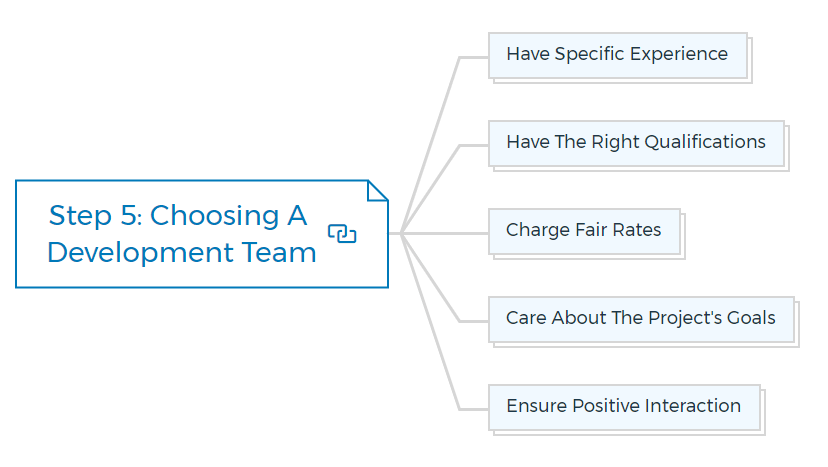
Have specific experience
Developers should only collaborate with experts who have knowledge and experience in the developed project. They should not allow them to learn from their mistakes on the developer's project.
Have the right qualifications
Make sure that each expert has the proper credentials for the job. This isn't a must-have, but it does give you an idea of how knowledgeable someone is.
Charge fair rates
Verify that the fees charged by the professionals are reasonable and in line with the going rate for the services they provide. Getting a couple of quotations from equally qualified people would help.
Care about the project's goals
Potential team members who inquire about the project's goals show interest. Those that appear uninterested are the type of consultant who is solely concerned with completing the assignment and collecting their money.
Ensure positive interaction
A successful development team is one in which all members work together. Each team member should believe that the task's success is more important than their ego.
Don't hire people who prioritise their ego over success since they will cause problems as the task proceeds. One can identify the size of the crew by the scope and nature of the project.
A larger project, such as a high-rise residential building or a mixed-use complex, will necessitate a larger team. The developer, and the architect, are two crucial professionals who, in my experience, will assist the project progress in the right way.
These are the key agents and representatives for the developer. Because these two individuals have worked with other consultants, getting these picks right makes the team selection easy.
They can recommend qualified consultants with knowledge and experience related to the project based on their working experience and contacts with other industry members. Not all professional consultants may be necessary for the development approval application.
The developer's town planner or architect should verify with the local council for a list of documents needed for the application, as each council's criteria differ.
Property Development Checklists
Stop Second-Guessing Yourself
POWER BUNDLE
Finally! A way to Free your mind from worrying
about every possible expense that could derail your project.
3 x Powerful & Detailed Checklists
Compiled Over 10 Years Of Hands-On Experience
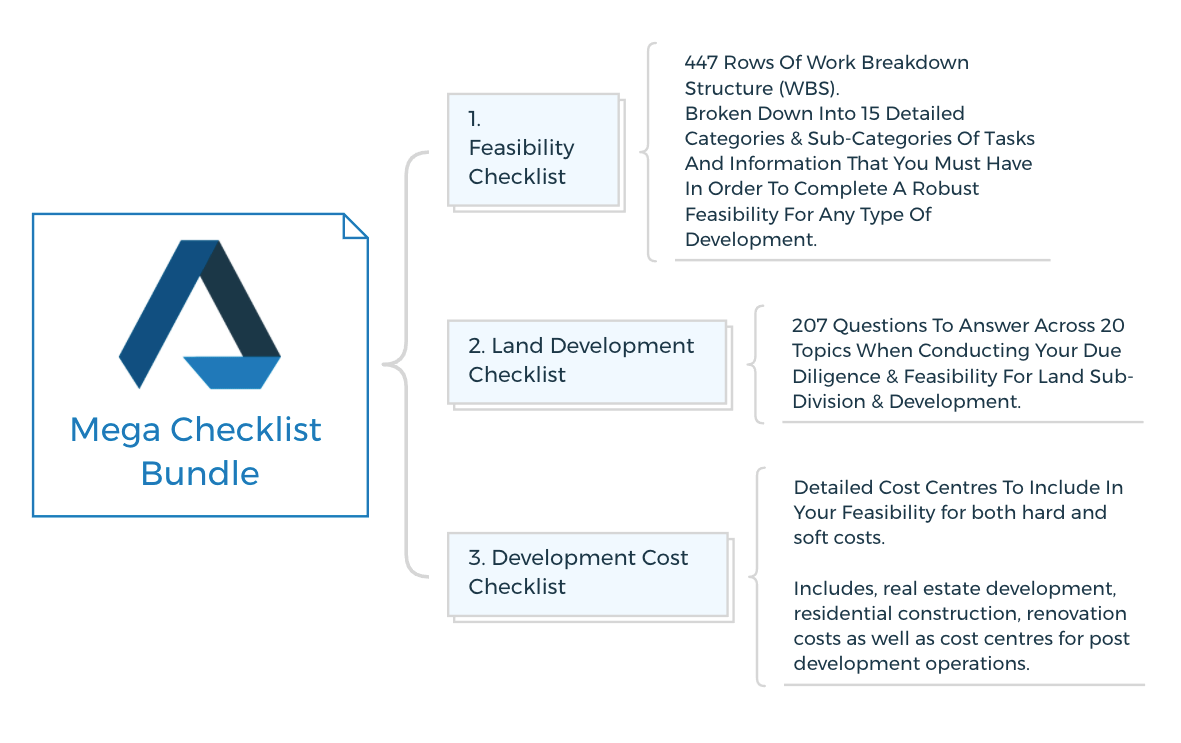
Mega Checklist bundle
✓ Feasibility Checklist
✓Land development checklist
✓Development, Construction & operational Costs Checklist
✓ 447 Rows Of Work Breakdown Structure
✓ 232 Costs To Consider Just On the Developer Side
✓ 524 Cost centres to consider on the construction & remodelling side
✓ Detailed operational costs
✓ 26 Revenue & 78 Expense Items To Consider
✓ Commercial (Retail, Office and Industrial) Side
✓ 31 Revenue & 138 Operating expense heads to consider
Step 6: Concept development
This stage is where doing your due diligence is crucial. You should avoid the following risks -
- Not analysing the site's restrictions and prospects before laying out the plans
- Not correctly reading or comprehending planning controls and planning tools
- You are not putting your ideas through a stress test with the consent authority
- Not paying attention to the consent authority's feedback
- Excessively pushing the envelope.
Step 7: Budgeting for development approval
Following the selection of team members, you should create a budget for development approval costs based on the brief. Each consultant should draught a proposal that addresses the following topics:
- The scope of each consultant's obligations should be divided into the numerous services, which should be specified under:
- services for pre-construction
- services for contract documentation
- contract management services
- It's also essential to figure out how much time they'll need to complete their tasks. Because most projects are on a tight timeline, each consultant must be committed to achieving their assignments on time.
- The fee and payment schedule are a part of the consultant's agreement. You can fix the price structure as fixed, hourly, or a percentage of the costs.
It's best if the consultant quotes a charge that includes a guaranteed maximum cost for the service but only accounts for actual expenditures until the ceiling is reached. The developer can cancel the service at any moment and only pay for completed tasks.
- One should clearly define the consultants' services in their contract. Multiple copies of reports and construction documents and expensive architectural models and renderings must be accounted for. Expect high travel and communication fees if the consultant is out of town.

Budget for development approval
The developer can now create a budget based on the tasks that need to be completed during the development approval process and bids from individual team members. This will help in programming a cash flow analysis and the development application's management requirements.
This phase's budget should be roughly 1% of the entire development expenditure as a general rule. To firm up the budget, the developer or appointed town planner or architect verifies with the council what documentation is required for the development application other than covering architectural work.
Budget management
The developer must find sources for these monies once the pre-development approval budget has been finished. They may have already used part of their funds, such as the deposit for the site, so one must supply the remaining budget before the consultants can begin their job.
Because these funds, known as the "seed capital," are in danger, the developer must carefully manage them. This money is provided by the developer, joint-venture partners, lines of credit, or investors.
To properly handle the seed money, the developer must set up a system for expediting approvals, initiating work activities, controlling expenditures, approving bills, and accurately reporting expenses.
The developer can choose from various accounting software packages on the market to suit the project and the organisation.
Step 8: Organize your work tasks
The most effective technique to manage the pre-development approval process is to schedule all of the team's actions. The developer can create a timetable using software such as Microsoft Office Project to highlight various stages of the project and work completed by each development team member, thus identifying important route sequencing.
In this approach, the developer can receive significant insight into the linkages between concept design, funding, planning, marketing, construction, and various other activities and better understand the complicated collection of work tasks remaining for completion.
The schedule will help the developer manage the team to gather critical information for taking important decisions. One can use these schedules for various reasons throughout the process.
Some formats may be similar, but they will be used for different goals, depending on the squad composition at the moment. The first schedule will be general or summary, listing major job activities but with little information.
The timetable will become more detailed as the team develops and the activities increase. The manager should generate precise timelines during the pre-development approval phase to successfully run the process.
Although you should examine the process, other actions will begin once the work has started, allowing the developer to know what is required ahead of time.
Step 9: Architectural design and master planning
A startup meeting of the team is recommended before the work begins after the development approved budget has been examined, the development team has been picked. The overall work tasks have been scheduled. The programme, as well as relationships and lines of communication, should be created at this conference.
The town planner and architect, along with any required engineers, are in charge of analysing the design programme to the community and building codes to generate a product that the developer can sell.
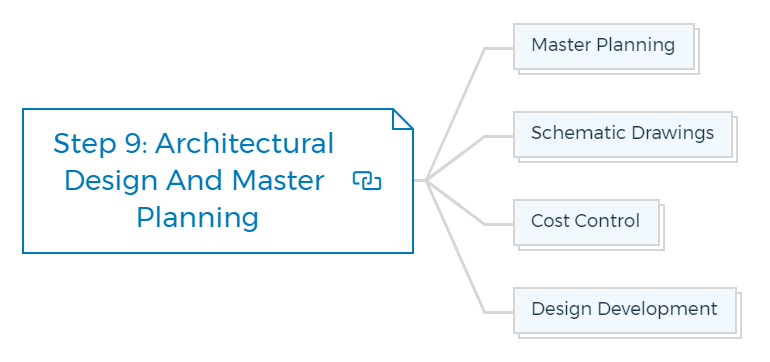
Master planning
When more significant sites, such as residential land development, are involved, an architect or a town planner will analyse and draught a master plan for the entire area.
Schematic drawings
After researching the legal and site information, the architect might design the preliminary designs and sketches. The developer's financial package will then comprise the initial plans and specifications, which will include the following:
- layout of the site
- elevations on the outside
- floor layouts for the interior
- portions of the wall
- visualisation
- a list of requirements
Cost control
These preliminary blueprints will be given to the quantity surveyor, who will provide the developer with an estimated cost for the project. If the developer is satisfied with the pricing, the architect and engineers will prepare design development drawings for more thorough costing.
Design development
The architect and engineers create these drawings as the second stage, expanding on the concept drawings. They're detailed enough to provide development and marketing cost estimates.
Step 10: Perform a feasibility analysis
After completing the design and preliminary costings, the developer or development manager conducts a feasibility study. This is, without a doubt, the most crucial step in the development approval process.
A complete feasibility study will essentially tell the developer whether the proposed development is financially viable. It will notify the developer if the estimated returns add up and the profit margin that can be expected upon the project's completion.
Numerous feasibility software packages are available that can simplify the calculations. The developer's judgments and analyses, on the other hand, are only as good as the data and figures entered into the programme.
If the feasibility study determines that the project is not financially feasible, the architect and the rest of the design team should rethink or refine their plan. They must identify and eliminate non-essential costs while maintaining functionality and quality.
Materials available, building methods, transportation concerns, site limitations or restrictions, planning and organisation expenses, profitability, and so on will all be considered.
Step 11: Preliminary development financing
After completing the feasibility study, the developer should approach a few financial institutions to measure their interest in financing the project. With terms and conditions, obtaining preliminary development money in concept will give the developer confidence for the project.
A preliminary finance offer will also give the developer an idea of debt obtained and whether further equity is needed. The developer will either secure the necessary finance or use a mortgage broker. If required, there is time to raise more equity while the development plan is being assessed for approval.
Step 12: Consents or Approvals
Development approval is necessary to consent by the relevant authority that approves a development to occur. Consent or development approval has 3 categories:
- Consent to the Development Plan (planning permission);
- Consent to the Building Rules;
- Consent to the Land Division.
You will not get Development approval until you have all of the various types of consent required for the project.

Different kinds of consent
Depending on the sort of development, different types of consent are required.
Planning Consent
Development that may influence people or an area, such as new dwellings, altering the function of a building, such as from an office to a shop, or changing the use of land, such as from pasture to vineyards, typically requires Planning Consent.
A planner handles planning consent applications, evaluating them against the Development Plan, the Development Act, and the Development Regulations.
Building permit consent
Development that involves the construction of buildings and structures, such as a house, garage, or other systems, typically requires Building Rules Consent.
A building surveyor analyses the application against the technical requirements of the State Building Code and other applicable state standards. It covers a wide range of topics, including
- Structural adequacy
- Fire Safety
- Health and Amenity
- Accessibility for those with disabilities
- Energy efficiency
The council or a "private certifier" can grant a permit. A private certifier is an independent practitioner registered by the State Government to assess applications for Building Rules Consent and grant Building Rules Consent.
Land division consent
- Land Division Consent is for development that involves the movement of boundaries between properties, such as the amalgamation or construction of new allotments.
- A planner handles Land Division Consent after forwarding the application to other professionals for reviews, such as transportation and civil engineers.
- Both the State Government and the local government evaluate Land Division Consent.
Check government websites of your state and city for more details regarding the consents.
Whether you are in the United States, Canada, UK, Australia or in QLD, NSW, VIC, SA and or WA city, the development approval is essentially consent by the relevant authority that approves a development to occur.
Learn More
Step 13: Pre-Lodgment meeting with council (planning authority)
The pre-lodgement consultation procedure is crucial, as it can drastically cut expenses and the time it takes to make a decision. Check with your local council or planning authority about their pre-lodgement policy, as it varies from council to council. You can easily book a meeting for a small charge.
In my opinion, this is a crucial step in the Development approval process since it can disclose a lot about council employees, their interest in your project, and concerns you may not be aware of that will affect your submission.
Step 14: Submit a development permit application
The chosen town planner or architect will organise the submission and application for development approval, having learned which papers will be required for them to make the planning assessment from the council's planning services department.
Other consultants' studies may require a traffic effect analysis, noise impact study, or environmental evaluation. Before submitting the formal application, the town planner or architect should meet with authorities from the planning department to present the development project and solicit their feedback and comments.
This has been shown to help speed up the approval process.

Lodgment of the development application
Make sure you thoroughly grasp the DA process and the decision-making process within the council and other authorities who will decide whether or not your submission will get approval.
Here are some suggestions for getting it correctly the first time:
Make sure to complete the application form accurately
Submit all needed information and the correct number of plan copies if necessary. It won't happen if you can make an electronic filing. If you submit a well-prepared and complete application for development approval, you will avoid delays.
Pre-Lodgment meetings
You would have received feedback from the council if you had a pre-lodgement meeting. Ensure to address all issues mentioned during the pre-lodgement process in the application.
Statement of environmental effects
Ascertain that your town planner produces a comprehensive Statement of Environmental Effects. This statement is your 'business case' for receiving approval: it must be technically solid and handle any concerns on merits as necessary.
The SEE is - A written statement demonstrating that the applicant has evaluated the impact of the planned development on the natural and built surroundings. It also shows the proposed method/s to mitigate any adverse impacts.
Its purpose is to aid in the evaluation of a development approval application.
Step 15: Referrals
The EP&A Act requires the council to submit DA applications to other statutory authorities for review if the proposed plan impacts their authority. They can also obtain expert opinions on specific situations if necessary. The following are examples of common referrals:
- Heritage
- Department of Fire
- Transportation and maritime services
- Airport management.
As a result, you may need to submit specialised paperwork with your application.
Step 16: Notification
Similarly, the council has a responsibility to notify immediate neighbours and the general public that they are considering a development application. Notifying people is usually done by placing an advertisement in the local paper, on the council's website, or by writing to the neighbours directly.
Step 17: Assessment
The council has to consider the application in light of all applicable provisions, which are many. Here are some of the relevant instruments:
- Act Concerning Environmental Planning and Assessment (EP&A Act)
- State Environmental Planning Policies (SEPP)
- Regional Environmental Planning Policies(REPP)
- Instruments for Environmental Planning (e.g. IDOs, PSOs, LEPs)
- Council Policies and Development Control Plans (DCPs).
It's crucial to remember that councils are judged not just on their conclusions but also on how they arrived at those decisions — in other words, they must follow due process.
It is imperative when dealing with concerns from next-door neighbours, where you must help the council in assisting you. Consider the concerns of your neighbours and respond appropriately.
It will make it easier for the council to deal with any potential concerns if and when they arise.
Bonus: Handling objections in property development

I just wanted to address the question regarding handling objections when you get them. Usually, when you’ve got an objection or if it’s just one objection it is always better that you try and handle it at your end and approach the objector directly.
I’ll tell you the reason why. Yes, everything is good unless the council says, alright you need to provide shadow diagrams or you need to provide some screens to tackle privacy or whatever changes that the council would ask you to make so that that objection can be handled. That’s fine.
Dealing with council
If the council decides to brush them off, they can brush them off, no problem. In Victoria, the council will issue you with what is called a notice of decision or NOD.
Everything is fine so far, but don’t forget that even when you’ve got the NOD or the notice of decision there is a 21-day cooling off period before your notice of decision actually becomes a permit.
In those 21 days if that one objector is nasty they can go and lodge a claim with VCAT and delay your permit until a VCAT hearing. That is, it will not become a permit after the cooling off period.
Dealing with VCAT, QCAT, NSWCAT etc (Civil Tribunal)
You will have a VCAT hearing if you’re from Victoria. Just be wary of that. Even if the council decides to brush it off, I would … If I was doing this development, make contact with the objector and try and appease them and try and handle their objection.
If I have to do shadow diagrams and spend a little bit extra to do the shadow diagrams and go and show them that there are no shadows affecting their property – I would do that.
What I am really trying to do is show them that their concern won’t be a big enough reason for them to take you to VCAT. They are perhaps doing this because they can.
Once you go to VCAT, there’s a three month wait before you’ll get a hearing and when you get a hearing it will of course come in your favour, but what will end up happening is that it will delay your development. It will increase your holding costs and it will cause all sorts of grief to you as a developer.
If I was that person and there was one objection I would have a meeting with that objector to appease him.
Dealing with objectors
If the objector says look, show me the shadow diagrams, that’s when I’ll go and get the shadow diagrams to try and appease him so that they know that even if they did go to VCAT, it will cost them money and they won’t win anyway. That way, it will save you those three months.
Be careful with these objections and I’m saying this from my own experience because I’ve just gone through it recently. I’ve gone through the same experience with my 16 apartment development when we were getting the permit. We had 18 objections. So this is how you handle objections in property development.
Checkout our guide to Getting Started In Property Development.
We had a council consult meetings and in those meetings we tried to address all those objections as much as we could. We had the shadow diagrams done. We had everything that we could do to appease them.
There were some issues about noise because we were going to put car stackers. We got a noise report so that we could show them that the noise wasn’t anymore than what a normal air conditioner would make. Those are the things that I would suggest anybody, if you’ve got one or two objections it’s always better to go and see those objectors before you’ve got that permit because they’ve got 21 days to lodge an objection, again, in VCAT and take you to VCAT.
It doesn’t matter whether they win or they lose. Even if you know and your consultants tell you that everything is fine. You’ll win and come out on top. The problem is that you will lose three, four months and everything will get delayed. In those three, four months you may start your working drawings.
You may not start your working drawings. All these things will get delayed but you certainly won’t be able to start marketing them because you haven’t got a permit yet.
This is my feedback on handling objections. And if you would like to learn more about property development, I run a property development seminar and a property development course that you can undertake.
Step 18: Determination
The EP&A Act lays out the council's alternatives for making a decision:
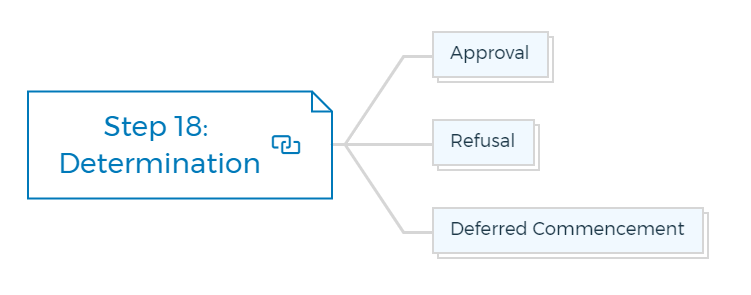
Approval
Your approval will be subject to specific criteria. You must thoroughly study your permission because it frequently contains activities that you must take. There are also deadlines to meet, such as the DA's expiration date. Although there is a short grace period when you can reinstate, this is usually only two years.
Nonetheless, I've encountered cases when an applicant has mistakenly allowed their DA to lapse and has had to reapply for a new DA. Worse, occasionally, the planned densities have changed for the worse, resulting in a significant loss of potential for the applicant. Remember that the council does not have the authority to reactivate an expired DA.
Refusal
The EP&A Act provides you with various review options in an application refusal case. The council's Notice of Refusal will include your review rights. In general, you can have the decision reviewed by independent council officials, which is the quickest and least expensive choice.
You can also file an appeal with the Land and Environment Court. Before taking any step, go through the rules stated on your state government websites.
Deferred Commencement
The EP&A Act provides you with various review options in an application refusal case. The council's Notice of Refusal will include your review rights. In general, you can have the decision reviewed by independent council officials, which is the quickest and least expensive choice.
You can also file an appeal with the Land and Environment Court. Before taking any step, go through the rules stated on your state government websites.
Considerations for obtaining a DA
Many development businesses have gone bankrupt due to going toe-to-toe with local people and council in an attempt to force through development plans that are often arrogant, or at the very least oblivious to the neighbourhood's character and residents' interests.
Choose an experienced architect familiar with your local government, the type of development you want to make, and your locality. It will be much easier for your architect to obtain a favourable outcome on your behalf if he has an excellent professional relationship with the council employees.
Similarly, when choosing a town planner (and the architect can assist you with recommendations), make sure the planner is well-versed in the council, its personnel, and the surrounding area in general. When the planner drafts their Statement of Environmental Effects (SEE) in support of your application, likely, they've already assessed DAs at the local council, which will come in handy.
I recommend that you go to the council where you're filing your DA. Ask to see some previous DAs similar to yours that have been approved or denied. Examine the planner's SEE or statement of impact. It will give you various information about what to expect when you lodge, including initial neighbour concerns.
The DA procedure is still somewhat lengthy in Australia. The good news is that state governments have been working for several years to overhaul planning legislation and implement changes relating to plan creation, assessment, and determination of development plans.
Summary
If the developer does not have a skilled and effective design team, the development approval procedure can be a lengthy and costly process. It can take a year or more to clear a complex project sparked community opposition.
If the application is approved, the developer will have increased the project's financial value and will be able to sell it to another developer or move through with the building phase.
Here's a quick rundown of the major things we discussed and the risks to avoid.

The following are some pitfalls to avoid:
- Inadequate research
- Lack of planning
- Communication breakdown with the consent authority (ask the right questions)
- Failure to recognise the significance of threshold issues.
- Incomplete or inaccurate data
- Inadequate knowledge of the political process
- Failure to foresee future issues.
Successful applicants:
- Recognise the procedure
- Complete their homework
- Prepare a great proposal
- Communicate clearly and at the correct times throughout the process.
- Effective problem-solving
- Recognise the difficulties at the tipping point
- Keep the final goal in mind.
Other considerations:
- Recognise the procedure
- Development's likely influence (on natural and artificial environments)
- The site's suitability for development
- Any complaints (submissions) received
- The general public's interest
So, this was how you could get development approval in the shortest amount of time.
FAQs

